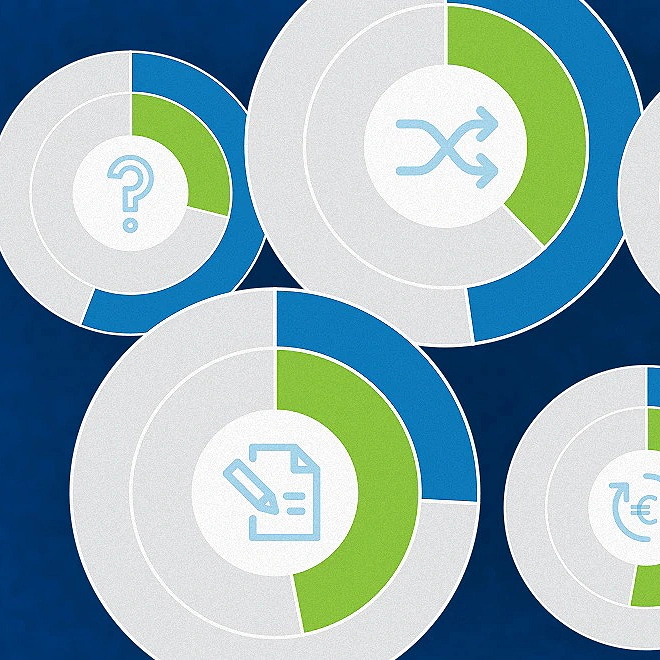Inclusion as the competitive advantage
The case for women in supply chain
THE workplace is becoming more diverse than ever before.1 However, many industries are still playing catch-up when it comes to attracting a workforce that is more reflective of their customers and more capable of meeting the technical, operational, and cultural challenges in the marketplace. In supply chain, this is exemplified by the lack of women in the workforce. For example, according to a 2019 Gartner study,2 women account for just 39 percent of the total supply chain workforce, despite accounting for more than half of the workforce. Further, only 11 percent of executive supply chain leadership positions are held by women.3
The traditional linear supply chain is evolving. Now a series of interconnected operational nodes of real-time information, digital supply networks can provide unprecedented end-to-end visibility and predictability into the activity and status of each activity in the supply chain (development, planning, procurement, manufacturing, or fulfillment) and extend that capability to suppliers and customers. For supply chain leaders interested in competing in this and future industrial revolutions and seizing the next competitive advantage,4 a nearly 20 percent gap between men and women employees presents a sizable opportunity.5 But it will take a lot more than just compliance with decades-old diversity mandates6 to successfully attract, develop, retain, and leverage this powerful talent pool. Addressing this challenge effectively will likely require companies to execute broad-based inclusion efforts that will draw women to be supply chain professionals and create an environment where all workers can flourish.
In fact, our research shows7 that a significant majority of companies intend to shift from diversity as a program to inclusion as a business strategy. But nearly one-third of companies in the same global survey say they are unprepared to do so, while only 20 percent claim to be fully ready. In other words, while all those surveyed admitted to promoting diversity, many companies still don’t have a clear road map to develop the tools and training necessary to build a highly inclusive workplace and realize the full benefits of inclusion.
Why does this matter? Inclusive organizations are twice as likely to meet or even exceed their financial targets, according to eye-opening research from Catalyst.8 Moreover, the same study found those same organizations are six times more likely to innovate, eight times more likely to improve business outcomes, and 35 percent more likely to outperform their industry peers. The message is clear: Inclusion is a critical ingredient for business success and essential to building the workforce of the future.
In this paper, on the lack of women in supply chain, we’ll examine the key trends driving the need for more women in supply chain; ways to assess your company’s inclusion readiness; and ultimately, strategies for hiring and retaining more women in supply chain.
Key trends driving the need for more women in supply chain
The increasing adoption of intelligent robotic automation is changing the nature of work and impacting the end-to-end supply chain. Although primitive automation began in the 1970s,9 today’s machine learning and artificial intelligence (AI) are a giant leap forward for the industry. As emerging technologies such as self-driving cars,10 digital voice assistants,11 and robotic process automation12 redefine tasks, many traditional jobs are being combined. For example, previously “siloed” activities such as logistics planning, coordination, and freight payment might be executed by one role or individual in the future, with the help of technologies like blockchain and the Internet of Things (IoT).
Further, to execute this as an integrated process, traditionally segregated logistics and distribution roles, such as logistics coordinators and billing specialists, might be consolidated—requiring individuals in the new roles to have knowledge of additional supply chain and non-supply-chain processes. In this way, individual workers would need knowledge of the organization spanning the end-to-end value chain, the skill set to collaborate cross-functionally, and the ability to adapt in a dynamic landscape.
“You need a blend of talent,” says Caryn Seidman-Becker, CEO of CLEAR.13 “You need those folks who can dream a product, those who can build the product, and the ones who can execute product delivery. Sometimes the best coders are poets. It’s really balanced, and we need a lot of each.” For many businesses, winning the skills war is becoming less important than nurturing the enduring human capabilities that underpin the ability to learn, apply, and effectively adapt them.
With that said, the supply chain industry is currently undergoing a significant skills shortage, which is exacerbated by rapidly evolving roles that are becoming increasingly harder to fill, according to a recent Deloitte report.14 Actively recruiting more female candidates may enable companies to cast a wider net and may be a compelling approach to addressing the skills shortage and driving supply chain forward.
As previously mentioned, there is currently a gender disparity in supply chain with 11 percent fewer women working in supply chain compared to other industries.15 Why might this be the case? Let’s look at an example from the manufacturing industry. According to a 2015 Women in Manufacturing study,16 two-thirds of respondents from the manufacturing workforce indicated that their organization did not have active recruitment programs tailored to female candidates, and further, only one-third reported that their employer was good at recruiting, retaining, and developing female talent.
The good news is—if companies desire to expand their target recruiting pool, there are strategies designed to help move the needle in the short and long term. In fact, pursuing avenues to widen the net and broaden the company workforce may help attract potential candidates. According to a 2017 Deloitte survey, 80 percent of respondents indicated that inclusion is important when choosing an employer and 39 percent indicated they would leave their current organization for a more inclusive one.17
Assessing your company’s inclusion readiness
Before diving in further, let’s first define diversity and inclusion. Diversity is the different skills, backgrounds, attributes, and perspectives that we each bring to the table. Inclusion is leveraging what makes each person unique in a way that encourages them to be authentic and feel that they are valued. While there is room for companies to improve in both regards, inclusion efforts (e.g., inclusive leadership, fostering inclusive team environments) will be critical components in the long-term strategy of bolstering a strong workforce of female talent in the supply chain space.
Many organizations understand the importance of increasing the number of women in supply chain and are seeking avenues to do so.18 Demonstrating a commitment to and culture of diversity and inclusion may help with these efforts because, as mentioned above, candidates are seeking for inclusive organizations.19 Knowing where your organization lies on our diversity and inclusion maturity model, a tool that can help leaders envision steps necessary to progress along the curve toward inclusion, can be a valuable first step in creating an actionable strategy for long-term growth (figure 1).

Regardless of where you currently land on the maturity scale, future performance will largely depend upon your organization’s ongoing ability to attract, hire, develop, retain, and empower a diverse workforce. With that in mind, here are some important points to consider when it comes to inclusive recruitment and retention:
- Hiring skill sets. As linear supply chains morph into end-to-end digitally enabled supply networks enabled by AI, machine learning, and cloud solutions, new roles will emerge that require a broader set of skills, cognitive abilities, and interpersonal characteristics. To that end, it’s important to focus your hiring practices on the greatest opportunity areas.
- Hiring bias. Because of human nature, bias can negatively influence recruiting. Hence, training recruitment teams on how to mitigate bias is critical. For example, some organizations are eliminating names on resumes to help avoid any unintended gender or ethnicity bias, according to one report.20 Others are using objective analytics to help identify more qualified candidates and create job descriptions that appeal across genders and races.
- Retention awareness. In a Glassdoor survey,21 67 percent of job seekers said that a diverse workforce is an important factor when evaluating companies, accepting job offers, and staying aboard. Therefore, it’s important to educate the market on your commitment and progress to not only becoming a more inclusive organization, but one that ultimately promotes and sponsors women from within, especially as they advance in their careers along the path toward leadership.
Organizations should think more holistically about how they identify, recruit, train, nurture, mentor, and promote a diverse workforce.
Strategies for hiring and retaining more women in supply chain
Historically, supply chain roles evolved around functional expertise that focused on optimizing segments of the supply chain using periodic analytics. The future will likely be highly dependent on digital supply networks with connected customers, suppliers, and functions. New roles will emerge that require a more complex and broader knowledge of key functional areas such as synchronized planning, warehousing, and autonomous logistics.
The workforce of the future demands leaders who inspire confidence and recognize an individual’s unique value. In our research and experience,22 the most mature and “integrated” institutions on the inclusive scale often do the following five things:
- Set the tone for diversity and inclusion at the top and drive accountability through the entire organization
- Understand that diversity without inclusion is not enough
- Focus on inclusive leadership
- Embed inclusion into the talent strategy
- Continuously evolve the diversity and inclusion approach as business and talent priorities evolve
So, what can you do today to move the needle on modernizing your inclusion approach and ultimately welcoming more women into the supply chain fold? We present a few considerations:
- Assess your stage in the maturity model. In which areas are you lagging or leading in terms of ownership, workforce, incentives, and support systems? How can you attract and retain more women in supply chain?
- Deep dive internally to understand the current landscape of women in your supply chain function and if there are any pain points for attraction and/or retention that can help tailor your approach.
- Refine and groom your talent pipeline to match the changing skill sets. Once you understand your place on the maturity scale, consider ways to identify and foster talent for the future. That could include sponsorship with female STEM programs or collaborating with existing organizations.
- Integrate your planning. Not only can AI-driven23 processes help improve both your front-end and back-end operations with more accurate demand data, they can be used to orchestrate both your supply chain talent and address inclusion gaps.
- Empower your organization through team, talent, structure, and policies built on cognitive diversity and inclusion. Understand what actions and metrics will drive organizational alignment across all levels on inclusive culture.
In a 2017 Deloitte survey,24 86 percent of respondents said that in 2016 their organizations were doing everything they could to create a workforce for Industry 4.0. In 2017, however, as more respondents recognized the growing skills gap, only half said their organizations were doing everything they could to fill the gap and develop the talent needed to compete for the future.
Obviously, inclusion won’t happen overnight. But progress can be made, especially after an honest self-assessment about your organization’s current maturity level. From there, it’s all about a focus on pipeline refinement and enacting policies that help your inclusion and profitability targets, which are, no doubt, inextricably linked. After all, inclusion is a massive opportunity for the supply chain profession as well.
Supply Chain & Network Operations
Deloitte Consulting LLP’s Supply Chain & Network Operations practice can help you imagine, deliver, and run your digital supply networks to address tomorrow’s challenges and opportunities—providing a platform for generating critical insights, optimizing business processes, and automating supply chain activities across your value chain. We tackle organizations’ most complex issues by drawing on global capabilities that span all areas of business strategy and operations across industries such as consumer and industrial products, financial services, telecom, and health care.
Learn more


